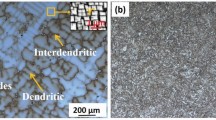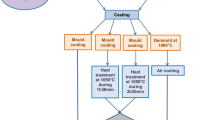Abstract
The research article deals with the corrosion behaviors of friction welded AISI 52100 grade high carbon and low chromium steel joints. In recent decade, plain carbon steels are replaced with AISI 52100 grade steel in automotive and aerospace sectors to overcome the corrosion defects. In general, the corrosion attacks are more susceptible in joints . Therefore, in this research work, the corrosion behavior of joints was analyzed in its interface and also the relationship between continuous drive friction welding parameters and properties of weld zone are established. The joints were prepared by varying the friction welding process parameters to optimize the required number of experiments. To predict the optimum properties of fully deformed zone, the empirical relationships were developed. The grain size was measured at various zones and the corresponding properties of the joints were analyzed by using scanning electron microscope, optical microscopy, and EDAX.
















Similar content being viewed by others
References
Bhadeshia HKDH (2012) Steels for bearing progress. Mater Sci 57:268
Mumin Sahin H, Akata Erol, Gulmez Turgut (2007) Characterization of mechanical properties in AISI 1040 parts welded by friction welding. Mater Charac 58:1033
Nicholas ED (2003) Friction processing technologies. Weld world 47:2
Uday MB, Fauzi MNA, Zuhailawati H, Ismail AB (2010) Advances in friction welding process: a review. Sci Technol Weld Join 15:534
Properties and Selection of Metals (1981) Metals handbook, 8th edn. vol 1, p 408
Sahin M (2004) Simulation of friction welding using a developed computer program. Mater Process Technol 81:53
Damodaram R, Ganesh S, Raman Sundara, Prasad Rao K (2014) Effect of post-weld heat treatments on microstructure and mechanical properties of friction welded alloy 718 joints. Mater Des 53:954
Ozdemir N, Sarsılmaz F, Hascalık A Effect of rotational speed on the interface properties of friction-welded aisi 304 l to 4340 steel. Mater Des (in press)
Sahin Mumin (2007) Evaluation of the joint-interface properties of austenitic-stainless steels (aisi 304) joined by friction welding. Mater Des 28:2244
Yoon Han-Ki, Kong Yu-Sik, Kim Seon-Jin, Kohyama Akira (2006) Mechanical properties of friction welds of rafs (jlf-1) to sus304 steels as measured by the acoustic emission technique. Fusion Eng Des 81:945
Kumar R, Balasubramanian M (2015) Experimental investigation of ti-6-4v titanium alloy and 304 l stainless steel friction welded with copper interlayer. Defence Technol 11:65
Ajith PM, Barik Birendra Kumar, Sathiya P, Aravindan S (2015) Multiobjective optimization of friction welding of uns s32205 duplex q3 stainless steel Q2. Defence Technol 11:157
Lee DJ, Jung KH, Sung JH, KimY H, Lee KH, Parkd JU, Shine YT, Lee HW (2009) Pitting corrosion behavior on crack property in AISI 304L weld metals with varying Cr/Ni equivalent ratio. Mater Des 30:3269
Li Wen-Ya, Min Yu, Li Jinglong, Zhang Guifeng, Wang Shiyuan (2009) Characterizations of 21-4n to 4cr9si2 stainless steel dissimilar joint bonded by electric-resistance-heat-aided friction welding. Mater Des 30:4230
Standard guide for examination and evaluation of pitting corrosion (2013) American Society for Testing and Materials standards, G46 − 94
Oldfield JW (1987) Test techniques for pitting and crevice corrosion resistance of stainless steels and nickel-base alloys in chloride—containing environments. Int Mater Rev 32:153
Fukumoto S, Tsubakino H, Okita K, Aritoshi M, Tomita T (2000) Amorphization by friction welding between 5052 aluminum alloy and 304 stainless steel. Scripta Mater 42:807
Paventhan R, Lakshminarayanan PR, Balasubramanian V (2011) Prediction and optimization of friction welding parameters for joining aluminum alloy and stainless steel. Trans Nonferrous Met Soc China 21:1480
Vairamani G, Senthilkumar T, Malarvizhi S, Balasubramanian V (2013) Application of response surface methodology to maximize tensile strength and minimize interface hardness of friction welded dissimilar joints of austenitic stainless steel and copper alloy. Trans Nonferrous Met Soc China 23:2250
Thirumalaikumarasamy D, Shanmugam K, Balasubramanian V (2014) Comparison of the corrosion behaviour of az31b magnesium alloy under immersion test and potentiodynamic polarization test in nacl solution. J Magnes Alloys 2:36
Chang JS, Qicx Y, Tian Z, Yun P (2016) Corrosion behavior of welded joints for cargo oil tanks of crude oil carrier. J Iron Steel Res Int 23:955
Gunaraj V, Murugan N (1999) Application of response surface methodology for predicting weld bead quality in submerged arc welding of pipe. Mater Process Technol 2:266
Tien CL, Lin SW (2006) Optimization of process parameters of titanium dioxide films by response surface methodology. Opt Commun 266:574
Selvamani ST, Palanikumar K (2014) Optimizing the friction welding parameters to attain maximum tensile strength in AISI 1035 grade carbon steel rods. Measurement 53:10
Sarsilmaz Furkan, Kirik Ihsan, Batı Serkan (2017) Microstructure and mechanical properties of armor 500/AISI2205 steel joint by friction welding. J Manuf Processs 28:131
Selvamani ST, Vigneshwar M, Divagar S (2016) Establishing the relationship between fatigue and tensile strength of frictionally joined metal matrix nanocomposite autogeneous joints for aerospace. Trans Indian Inst Met 69:431
Lakshiminarayanan AK, Balasubramanian V (2009) Comparison of RSM with ANN in predicting tensile strength of friction stir welded aa7039 aluminum alloy joints. J Trans Nonferrous Met Soc China 19:9
Subhash Chander G, Madhusudhan Reddy G, Venugopal Rao A (2012) Influence of rotational speed on microstructure and mechanical properties of dissimilar metal AISI 304–AISI 4140 continuous drive friction welds. J Iron Steel Res 19:64
Montgomery DC (2001) Design and analysis of experiments, 4th edn. Wiley, Hoboken
Pavethan R, Lakshminarayanan PR, Balasubramanian V (2011) Fatigue behaviour of friction welded medium carbon steel and austenitic stainless steel dissimilar joints. Mater Des 32:1888
Paventhan R, Lakshminarayanan PR, Balasubramanian V (2012) Optimization of friction welding process parameters for joining carbon steel and stainless steel. J Iron Steel Res 19:66
Huet F, Keddam M, Novoa XR, Takenouti H (1996) Time-resolved RRDE applied to pitting of fe-cr alloy and 304-stainless-steel. Corr Sci 38:133
Cangelosi VE, Taylor PH, Rice PF (1983) Basic statistics: a real world approach, 3rd edn. West Publishing Company, St. Paul minnesota, p 315
Montgomery DC, Hunger GC (1994) Applied probability for engineers. Wiley, London, p 471
Balta B, Arici AA, Yilmaz M (2016) Optimization of process parameters for friction weld steel tube to forging joints. Mater Des 103:209
Leckie HP, Uhlig HH (1966) Environmental factors affecting the critical potential for pitting in 18–8 stainless steel. J Electrochem Soc 113:1262
Behnken H, Hauk V (2009) Micro-residual stresses caused by deformation, heat, or their combination during friction welding. Mater Sci Eng A 289:60–69
Pantelis DI, Tsiourva TE (2017) Corrosion of weldments. Woodhead Publishing, Sawston, p 249
Conducting cyclic potentiodynamic polarization measurements for localized corrosion susceptibility of Iron—Nickel—or Cobalt—Based Alloys. Annual Book of ASTM Standards ASTM, G 61
Moteshakker Aboulfazl, Danaee Iman (2016) Microstructure and corrosion resistance of dissimilar weld-joints between duplex stainless steel 2205 and austenitic stainless steel 316L. J Mater Sci Technol 32:282
Madhusudhan Reddy G, Venkata Ramana P (2012) Role of nickel as an interlayer in dissimilar metal friction welding of maraging steel to low alloy steel. J Mater Process Technol 212:66
Handa Amit, Chawla Vikas (2013) Mechanical characterization of friction welded dissimilar steels at 1000 rpm. Mater Eng 20:102
Winiczenko Radosław, Kaczorowski Mieczysław (2013) Friction welding of ductile iron with stainless steel. Mater Process Technol 213:453
Ma C, Peng Q, Mei J, Han EH, Ke W (2017) Microstructure and corrosion behavior of the heat affected zone of a stainless steel 308L-316L weld joint. J Mater Sci Technol (In press)
Shirinzadeh-Dastgiri M, Mohammadi J, Behnamian Y, Eghlimi A, Mostafaei A (2015) Metallurgical investigations and corrosion behavior of failed weld joint in AISI 1518 low carbon steel pipeline. Eng Fail Anal 53:78
Acknowledgements
The authors are grateful to the Chancellor Dr. R. Rangarajan, Vel Tech Institutions, Chennai, for funding and the facilities provided to carry out this investigation. The authors wish to thank Dr. V. Balasubramanian, Director, CEMAJOR for extending the facilities of metal joining and material testing lab to carry out this investigation.
Author information
Authors and Affiliations
Corresponding author
Additional information
Technical Editor: Márcio Bacci da Silva.
Rights and permissions
About this article
Cite this article
Selvamani, S.T., Vigneshwar, M., Palanikumar, K. et al. The corrosion behavior of fully deformed zone of friction welded low chromium plain carbon steel joints in optimized condition. J Braz. Soc. Mech. Sci. Eng. 40, 246 (2018). https://doi.org/10.1007/s40430-018-1129-1
Received:
Accepted:
Published:
DOI: https://doi.org/10.1007/s40430-018-1129-1




